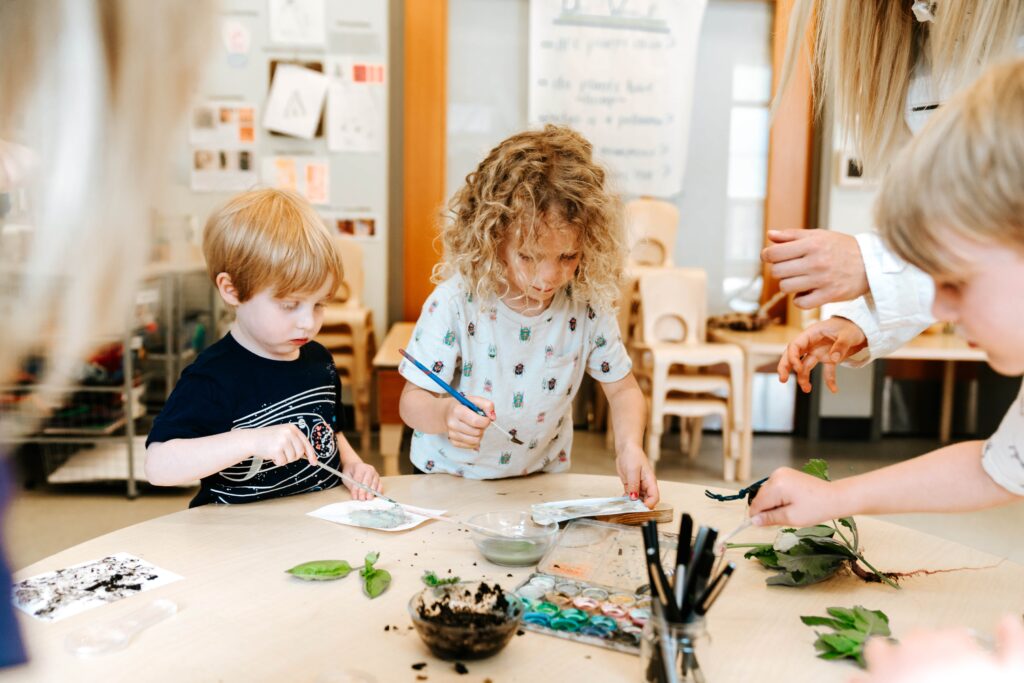
If you close your eyes and create a mental image of the classrooms where you spent your school years, we’re betting it looks a little something like this: a teacher’s desk and chalkboard at the front of the class, rows of desks facing the board or a semi-square of tables surrounding the perimeter of the room with space in the middle for a projector. You likely spent anywhere from 45 – 90 minutes in this one room before the bell rang and you moved on, through hallways lined with lockers, to the next classroom that was set up in a similar fashion. For most, the school building itself was probably designed 30 to 50 years ago based on learning models that were primarily teacher-centric and preparatory for institutional and industrial workplaces.
Sound familiar?
The fact is, if you walked into an average learning environment today you’d probably witness a similar design model. The times have changed, but this “cells and bells” model (Kohn, 1999) is still widely practiced. And from what we know, “this type of design…is in direct contrast to what we know about how students learn, how tomorrow’s teachers will need to teach, and all that we understand from educational research about the impact of learning space design” (Sheninger and Murray, 2017).
And we get it, renovating and building new schools costs money…a lot of it. Around $12 billion annually to be exact. But if we put the financial aspect aside for a minute and really looked at this gap between design and the needs of our learners, we have a hunch it has more to do with a misalignment, and even understanding, of values than anything else.
(Although, yes, dollar bills matter, too).
21st century success requires 21st century design

For the most part, our school administrators and teachers have good intentions when it comes to the design of their learning environments. When we spoke to a few, words like motivate, inspire, feel good, and feel safe were popular answers when we asked what they hoped their classroom design communicated and evoked. They described rooms that were brightly colored, decorated with inspirational quote posters and catered to specific learning styles through varied seating arrangements. Most were designed by the teacher, based on their likes and what they considered motivational, inspirational and welcoming. When we asked if the students had any agency throughout the year to influence the environment or if they felt the space reflected the values of the students, the answers were comparatively quiet — “Um, no. I never thought about that”, “I’m actually not sure”, “That’s probably a good idea.” So, good intentions, but still very much teacher-centric.

If we take a look at modern workplaces like Google, Apple, Pixar and even collaborative workspaces like WeWork, we see that more and more organizations are representing the core values of their business (and their people) through intentional design within their work environments. Knowing that ideals like collaboration and innovation are important, they’re engineering “casual collisions” or interactions to provoke unexpected conversations and new ideas. In their book, Learning Transformed: 8 Keys to Designing Tomorrow’s Schools, Sheninger and Murrary note that:
“These types of workplaces have embraced the mantra that a creative work environment motivates and inspires innovation…To get better results, they intentionally incorporated elements that foster creativity, collaboration, flexibility, and communication” (Sheninger and Murray, 2017).

So, new-age companies are designing workplace environments that not only matter to the people who work there, but contribute to better organizational outcomes overall. But what about schools? Can school administrators and teachers take a cue from modern workplace design and create learning environments that are inspirational, intentional, learner-centered and most importantly, foster improved student outcomes?
We think so. (And, no it doesn’t have to necessitate a Google-sized budget.)
Uncovering values and aligning intention
When we here at Teton Science Schools enter a school we’re working with for the first time, one of the first things we do is identify their values. Sometimes it’s as simple as looking them up on the school website, other times its more complex and involves conversations with the principal, head of school or a group of willing teachers. For us, uncovering these values helps us to identify the school’s intentional culture and align the work we’re doing with the ideals of the school and its stakeholders. And we do this in a number of ways.

When it comes to translating values into the design of the learning environment, it’s important that it not become an exercise in decorating and “Pinsperations,” but rather approached through a lens of mindfulness and constructive learner representation. So how can this be done?
We have a couple of suggestions:
- Bring words to life — If you like hanging inspirational posters in your classroom, try bringing those words to life in a different way. Give your students inspiring quotes and have them create their own visual images or ideas about how these words might be reflected in their classroom environment. A quote like,“Every person needs a place that is furnished with hope” by Maya Angelou may evoke images of nature, or home, or even summer camp. From there, your class can brainstorm ideas that translate those ideals into the space — maybe it’s a few plants they’ll tend to, maybe some comfier chairs, maybe a bigger space for quiet time. Whatever it may be, you’ll know that it’s reflective of your students’ values and that they had agency in creating it with you.
- Get creative — Depending on learning styles, students will have different ways of bringing values to life. Give students choice in how to translate their ideals by guiding them through an exploration of values and then allowing them creative freedom to express those ideals through writing, sketching, painting, or even song. Start by giving each student an index card to write down a value they’d like to see represented in their learning environment (either the physical space or social-emotional space created through rituals, policies and routines). Collect the cards and group them into similar categories. Then break students into groups to creatively make meaning of these abstract ideas and from there, brainstorm how their creative interpretations translate into practical examples.

However you choose to go about it, remember that it’s likely that it will (and should) change. As Lella Gandini, leading voice for the Reggio Emilia approach, expresses:
“In order to act as an educator for the child, the environment has to be flexible: it must undergo frequent modification by the children and the teachers in order to remain up-to-date and responsive to their needs to be protagonists in constructing their knowledge.”
At the end of the day, investing in intentional learning environments is investing in learners and the least we can do is make sure they feel intrigued, respected, and eager to spend their days living and learning in a classroom they helped create.


